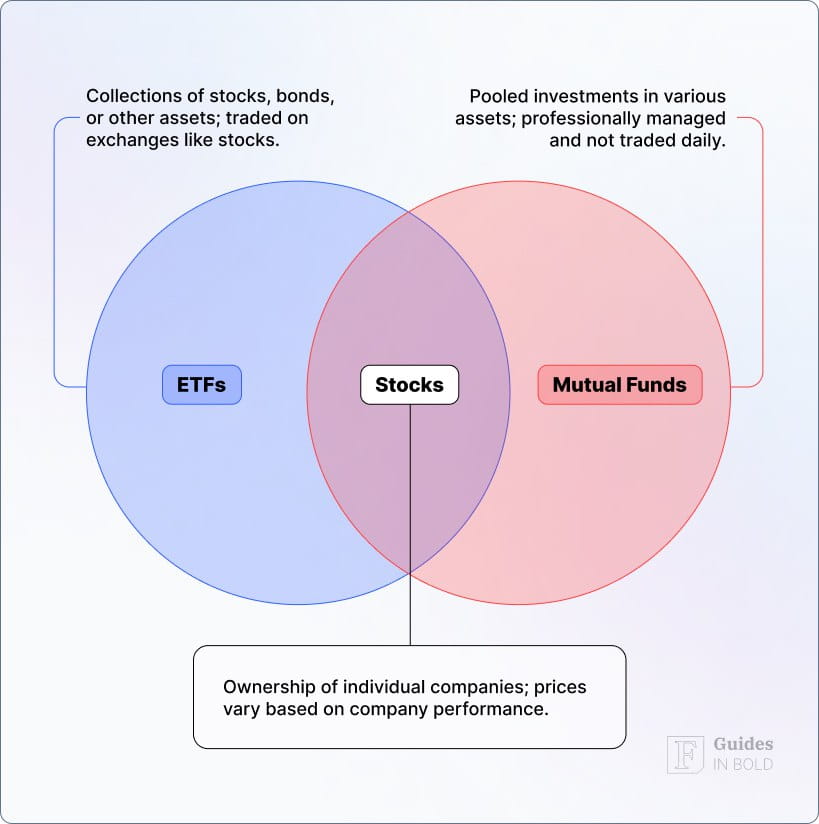In this guide you will learn what exchange-traded funds (ETFs) are, how they work, the various types of ETFs available, their advantages and disadvantages, among other important aspects. Additionally, we will share common ETF investment strategies to get you started.
Best Platform for Worldwide Stock Trading & Investing
-
Highly trusted multi-asset broker with clients in over 200 countries
-
Trade on 150 markets globally from a single platform (stocks, ETFs, futures, currencies, crypto & more)
-
Low commissions starting at $0 with no platform fees or account minimums
-
Easily fund your account and trade assets in 26 currencies
-
IBKR pays up to 4.58% interest on cash balances of $10k or more
Summary
– They hold a basket of assets, such as stocks, bonds, or commodities;
– Benefits include diversification, low fees, real-time trading, and transparency;
– Types include stock, bond, commodity, and sector/thematic ETFs.
What is an ETF?
The concept may be familiar if you are conversant with mutual funds and how they operate. The most significant difference between an ETF and a mutual fund is that while the fund sponsor maintains a mutual fund, an ETF is listed on a stock exchange where it is traded similar to stocks.
ETFs offer more diversification than investing directly in stocks, bonds, or commodities. An ETF can be created that tracks the prices of a group of these assets.
Watch the video: What is an ETF and why have they become so popular?
How ETFs work?
ETFs are very similar to mutual funds and stocks. They track the performance of a group of assets and can be traded throughout the day on the stock market. This introduces diversity and flexibility in assets.

An ETF provider can create an ETF based on anything from a single asset to thousands of underlying assets. ETFs are often designed to track the performance of index funds, such as the Standard & Poor 500 (S&P 500).
However, is it entirely possible to have a single-asset ETF tracking the performance of a commodity such as Gold, a virtual currency such as Bitcoin, or even a single sector such as tech stocks.
Expectedly, the performance of an ETF will vary from the net asset value (NAV) of the fund (i.e., the market value of the underlying assets). This means that the ETF shares would be trading either at a discount or premium when the value varies.
The ETF providers can correct this divergence by redeeming the fund. The process is simple. The ETF provider (or authorized provider, AP) can increase the supply of the ETF shares whenever it’s trading at a premium or reduce the shares whenever it’s trading at a discount. The law of supply and demand will help correct the price.
ETFs types
ETFs are mainly categorized according to their underlying assets. This means that if the ETF represents commodities, then it is a commodity ETF. If it represents traditional assets such as stocks, bonds, currencies, or index funds, its identity is derived from these assets.
ETF categories can overlap, and an ETF can be categorized in more than once. For instance, if an ETF represents a stock index, the ETF can be classified as either a stock ETF or an index ETF. Similarly, an industry-specific ETF could also be a stock ETF for companies within that industry.
Here are the most common types of ETFs:
- Stock (Equity shares) ETFs;
- Bond ETFs;
- Commodity ETFs;
- ndustry/Sector-specific ETFs;
- Currency ETFs;
- Inverse ETFs.
Now let’s look into each in more detail.
Stock ETFs
ETFs tracking stocks are perhaps the most common category out there. They represent a wide array of stocks, and these kinds of funds can be created to represent any form of equity shares trading on any exchange.
Some ETFs that can be sub-categorized under stock ETFs include:
- Value ETFs track the performance of cheap stocks in the market with the potential to explode in value.
- Stock index ETFs track the performance of the stock indices such as NASDAQ 100 or the more popular S&P 500.
- Dividend ETFs track the performance of stocks whose companies have a good history of paying out dividends to investors.
- Style-dependent ETFs offer exposure dependent on the investors’ trading style. Some investors choose to invest in more risky low-cap stocks, while others prefer the less risky middle to large-cap stocks. Small, middle, and large-cap stocks are offered by companies valued at $200M-$2B, $2B-$10B, and $10B+, respectively.
- Foreign-market ETFs are designed to track stocks on foreign exchanges such as Japan’s Nikkei Index, China’s Shanghai Stock Exchange (SSE), Europe’s EURONEXT, and LSE Group serving the UK and Italy. There are ETFs with foreign-based underlying assets that are not stocks.
Commodity ETFs
Commodities are physical goods and products whose value is speculated upon on a trading platform. These goods include precious metals such as gold and silver, agricultural products such as coffee, wheat, corn, etc., and nonrenewable resources such as crude oil or natural gas.
ETFs can be designed to track the value of these items or the share value of publicly traded companies that deal in these items. This way, investors have exposure to the entire commodities markets or a segment of them depending on which items are included in the fund.
Examples of commodity ETFs are USO and UNG, which track crude oil and natural gas performance.
Bond ETFs
Bonds are loan instruments used by governments, states, and companies to raise funds for specific projects and operations. The bond issuer will create a debt instrument that is offered to the investor. In a typical bond agreement, the bond issuer requests a loan from the investor for a specified period.
Upon expiry of the loan period, the bond issuer will repay the borrowed funds together with a stated interest. Bonds are often referred to as fixed-income investments because the interest is predetermined.
Bonds can be traded on an exchange as a security allowing the original bondholder (investor) to sell it in the open market.
Bond ETFs track the value of these debt instruments in the exchange market. They can be based on such bonds as government (treasury), corporate, local (municipal), or international, among several others.
Sector/Industry ETFs
Industry-specific ETFs are designed to track stocks within a single sector. There are 11 broad sectors as defined by the Global Industry Classification Standard (GICS). These are:
- Energy;
- Materials;
- Industrials;
- Utilities;
- Healthcare;
- Financials
- Consumer; Discretionary;
- Consumer Staples;
- Information Technology;
- Communication Services;
- Real Estate.
These sectors are important in grouping companies with similar business models, which simplifies performance comparison. Most investors prefer to invest within a specific industry or sector due to familiarity, access to information, or a myriad other reasons.
Sector/Industry-specific ETFs give you exposure to stocks within the various sectors similar to investing in stocks directly but now with the added convenience of diversification at a fraction of the cost of investing in several stocks separately.
Currency ETFs
The foreign exchange scene is vibrant, and investors can get exposure through direct investments or through ETFs. Currency ETFs can hold single foreign currencies such as the Euro, British Pound, or the Japanese Yen.
Alternatively, some ETFs track multiple currencies offering investors a diversified portfolio to the forex market.
Inverse ETFs
The inverse ETFs operate counter-intuitively by gaining with a drop in value of the underlying assets. Think of this as shorting a stock. In this case, an investor expecting a decline of a stock would open a contract to purchase a stock at a lower price in the future.
If the stock falls, the value of the contract rises, and if the stock value increases, the investor loses money and has to purchase the stock at the predetermined date at the then price.
Inverse ETFs work similarly by inversely tracking the value of the underlying basket of assets.
Cryptocurrency ETFs
Cryptocurrencies are a controversial topic at the moment, with most investors opting to stay away from the nascent market due to extreme volatility and lack of proper regulations. In the United States, the financial market regulators are reluctant to approve an ETF that directly tracks the value of cryptocurrencies such as Bitcoin or Ethereum or even a group of these assets.
Does that mean that if you live in the US, you have no access to crypto ETFs? On the contrary, there are ETFs already trading on popular US exchanges such as NYSE and NASDAQ.
These ETFs track the performance of publicly traded stocks of companies within the blockchain industry. Notable examples of these ETFs are Amplify Transformational Data Sharing ETF (BLOK) and Reality Shares Nasdaq NexGen Economy ETF (BLCN).
BLOK consists of 55 value stocks, while BLCN holds stocks of 74 companies, including such companies as Galaxy Digital Holdings and Overstock. The BLOK ETF’s provider has over $1 billion in assets under management (AUM) invested in the ETF, while BLCN’s has about $280 million of AUM.
If you live outside the US, you can invest in ETFs with more direct exposure to crypto assets such as Canada’s Purpose Bitcoin ETF (BTCC) and Switzerland-based 21Shares range of products tracking various crypto assets. 21Shares AG offers ETFs tracking indices, single assets, and an inverse ETF based on the value of Bitcoin. The ETFs are available for trading on the SIX Swiss Exchange.
5 ETF investing strategies
There are several ways to approach exchange-traded funds to make them work for you. There is no single strategy that fits all investors, and neither is there that will satisfy a single investor’s investment style.
More often than not, different situations will call on different investment styles, and this is just as true with ETFs as it is with the stocks, bonds, commodities, or foreign currencies.
Now, we will introduce you to the five most common ETF investing strategies. However, it is important to experiment and find one that perfectly suits your needs and investing style.
1. Dollar-Cost Averaging (DCA)
This is a common investment strategy in stock markets, and expectedly it works just as well when applied to ETFs. Dollar-cost averaging involves purchasing a fixed-dollar amount of an asset, in this case, ETF shares, in regular intervals regardless of the price action.
The goal of this strategy is to average out the entry point for the asset. An investor unsure of whether the asset has reached a turning point can use the DCA strategy, which either lowers or raises the entry point depending on the turning-point price of the asset.
Additionally, the technique can be used as a savings strategy with the investor buying into an asset slowly through regular investments until they achieve a set amount.

2. Core & Satellite strategy
As alluded to in the title of this strategy, the core and satellite technique involves investing in more than one ETF fund. The main one (called the core) will consist of a less volatile and more general portfolio based on the large indices such as the SPDR S&P 500 (SPY), which tracks the S&P 500 Index (with 500 stocks), or the iShares Russell 2000 (IWM), which tracks the Russell 2000 small-cap index (with 2,000 stocks).
The satellite will consist of other ETFs that are complementary to the core ETF but provide exposure to either riskier assets or less diverse assets. The satellites could be sector/industry or commodity ETFs.
This strategy is advantageous as it enables the investor to gain exposure to a broader array of assets in the market while also implementing more than a single investing strategy.
3. Strategic Asset Allocation (SAA)
The SAA is often used as a long-term asset investing strategy enabling the investor to gain strategic exposure to specific assets. The technique is usually applied through percentage allocations—for instance, 50/50 exposure to stocks and equity shares or a 60/40 in favor of either.
This ratio varies with changing investor goals, and sometimes new assets could be introduced, such as commodities or cryptocurrencies, making the final asset allocation result in a 40/30/20/10%.
Rebalancing can be done at specified intervals to ensure that the ratio of the assets is maintained at the set levels. This is important because this strategy relies on risk analysis, and the risker an asset, the less it is allocated within the portfolio.
4. Tactical Asset Allocation (TAA)
TAA is a short to mid-term ETF investing strategy. Think of it like swing trading, where the investor picks an asset or a group of assets that they expect to rise or fall in short to medium term periods.
They can then trade these ETFs, given that ETFs are listed on public exchanges, and they are available for trading throughout the day. This benefit is not accrued from investing in other derivative assets such as mutual funds despite their similarities to ETFs.
Tactical asset allocation is beneficial since it gives investors a more active approach to their investments. Investors have varying approaches to investing, and some have the time to trade ETFs. Using TAA is one of the strategies they can use to gain exposure to several assets otherwise not accessible due to geographical limitations or regulatory restrictions, among other reasons.
5. Sector Rotation
Sector rotation is closely related to TAA that we have discussed above. However, it may also be applied on a longer-term period.
Using this strategy, an ETF investor can rotate between investing in sector/industry-specific funds that provide them the exposure they desire dependent on performance or the need to protect themselves from adverse market conditions.
An investor may opt to invest in a single sector exclusively or multiple sectors. Whenever they feel a given sector they are invested in has little upside left, they can switch to another more promising sector. This way, they are more actively involved in the investments they make and less susceptible to passive investment risks.
How to invest in ETFs: Step-by-step
There are three steps to investing in ETFs. These are:
- Setting up a brokerage account;
- Researching ETFs using ETF screeners;
- Buying ETFs.
The three-step process is simple and straightforward so let’s consider what you will be doing through each.
Step 1: Set up a brokerage account
There are two ways to invest in ETFs. First, you can opt to DIY (do it yourself) through an online discount brokerage account. This way, you get to research and invest in your ETFs independently. If you choose this route, there are a few considerations to make when it comes to picking your ideal broker. These are:
- Fees – how much the broker charges for trading and maintenance;
- Minimum deposit – most have zero minimums but there are some with minimum deposits or ETF shares to invest in;
- Types of assets – does the broker offer access to a variety of ETFs?
- Customer service – does the broker have a good reputation in terms of customer service?
To start you off with your search for your ideal broker, here are some of the most popular online discount brokers you can consider:
The second way to invest in ETFs is the passive route of using robo-advisers (autopilot investing). These are financial service providers that utilize automated algorithms for recommending assets in which to invest. This is ideal for new investors and those seeking to invest passively.
The most popular robo-investors in the market include:
Step 2: Research ETFs using screening tools
This step is only relevant to DIY investors as we determined in the first step. If you choose to invest in ETFs without using robo-advisors, you will have to search and find the best assets to include in your portfolio.
There are thousands of ETFs in the US financial market. Therefore, it will be feasible to carry out this step manually. What you will need are ETF screeners. These are just databases of ETFs sorted and categorized to make the process of searching for your next investment opportunity easy.
Three of the best ETF screeners to consider are:
The best screeners will offer you the tools to filter according to your preferred criteria and you want to pay attention to the following factors when choosing the best fund to invest in:
- Holdings – these are the underlying assets constituting each fund. This filter will allow you to choose the best fund giving you exposure to the sectors of the market you want to invest in.
- Attributes – this filter enables you to sort between active and passive ETFs. A majority of ETFs are passive but there are some that are actively managed.
- Expenses and dividends – ETF costs are measured in terms of expense ratios and typically ETFs are cheap but some are cheaper to invest in than others. Also, some ETFs earn their investors dividends making them more attractive than others that do not.
- Themes – these filters enable you to sort the ETFs according to the sectors or industries in which their underlying assets operate. They include AI, blockchain, health, marijuana, tech stocks e.g., FAANG (Facebook, Apple, Amazon, Netflix, and Google), etc.
- Liquidity – this filter allows you to sought the ETFs according to the daily traded volume. The higher the trading volume the more liquid the ETF and vice versa.
- Performance or Returns – this filter will allow you to pick out the top-performing ETFs from the duds in the market. Even though past performance does not guarantee future returns, history does often repeat itself and the chances of a past good performer to keep making good returns are higher than a poor prior performer.

Step 3: Buy the ETF
Assuming your account was fully set up and funded, go ahead and make your purchase. ETFs are traded on the stock market just like stocks. This means you can buy or sell them at any time within the trading day.
Tip
Best Crypto Exchange for Intermediate Traders and Investors
-
Invest in cryptocurrencies and 3,000+ other assets including stocks and precious metals.
-
0% commission on stocks - buy in bulk or just a fraction from as little as $10. Other fees apply. For more information, visit etoro.com/trading/fees.
-
Copy top-performing traders in real time, automatically.
-
eToro USA is registered with FINRA for securities trading.
ETFs Pros and Cons
Just like most investments, ETFs have their merits and drawbacks. These are important to consider when developing an investment strategy that works for you.
It’s entirely possible to invest exclusively in ETFs, but including other financial instruments such as mutual funds, stocks, bonds could prove worth it to your particular situation. Here are the pros and cons of investing in ETFs.

Pros
- Diversification – perhaps the most significant merit to investing in ETFs is the level of diversification these assets provide. ETFs offer exposure to various underlying assets, including stocks, bonds, commodities, and currencies. You can invest in a single-asset ETF or one that tracks an index with thousands of tracked assets. This is beneficial because it reduces risks and increases opportunity.
- Lower costs – ETFs management attract is charged using an expense cost/ratio. In the financial markets, investors have the option to invest in single stocks or indices. With ETFs, the investors can invest in a single asset that tracks thousands of these stocks at a fraction of the cost by cutting back on broker commissions. This is not just convenient, and it’s also cheap and fast.
- Transparency – the price and performance of an ETF are easily accessible and verifiable on an exchange. Additionally, most ETFs are based on indices such as the S&P 500, and regulations provide that providers of these ETFs disclose fund holdings daily to the public. Mutual fund providers, for example, only disclose this information monthly or quarterly.
- Accessible – ETFs are easy to trade, and they are listed on public exchanges just like stocks or bonds, allowing investors to buy, sell or trade ETF shares all day long within market operation hours.

Cons
- Overvaluation – we described this situation earlier, but, in brief, there are rare situations in which ETFs could be trading at a premium. This means that the ETF shares are valued higher than the net asset value of the underlying assets. This situation is not ideal since investors will avoid investing in the ETF because it is more expensive.
- Costly – yes, ETFs, when managed passively, are cheap compared to investing in single assets, but then investing in ETFs can get expensive when actively managed and when using short-term investing strategies.
- Liquidity – problems with liquidity may not be an issue when it comes to the high volume, high demand ETFs but it is undoubtedly a concern with low trade-volume ETFs. The thing is, ETFs are prone to the economic laws just like most assets and with falling demand comes falling prices. Lowly traded ETFs can be hard to offload.
Conclusion
ETFs are becoming more popular, and for a good reason, they are easily accessible, very convenient, and cheap to invest in, especially when passively managed. The best merit, however, is that ETFs offer investors much-needed diversification.
This is why, as we highlighted in the introduction section, millennials, and retail investors are flocking toward the asset class, causing the asset class’s growing popularity. The new generation of investors has explored ETFs and index funds to bet on market rallies and global trends.
ETFs are an excellent addition to anyone’s portfolio, not just millennial investors. And they are a neat way to access assets that you may have otherwise not been able to, including international markets and developing sectors such as the blockchain industry.
We hope you learned enough to go out and discover ETFs for yourself. Experiment with the strategies we shared in this guide, and best of luck with your investment journey.
Disclaimer: The content on this site should not be considered investment advice. Investing is speculative. When investing, your capital is at risk.
Exchange-traded funds | FAQ’s
What is an ETF?
An ETF is an investment fund. The term ETF stands for ‘Exchange-traded fund.’ Like mutual funds, ETFs are funds consisting of a basket of securities, including stocks, bonds, commodities, or currencies. Unlike mutual funds, ETFs can be traded on stock exchanges, bought, and sold just like regular stocks.
How do ETFs work?
ETFs work similarly to mutual funds with some notable differences. ETFs are based on other securities such as stocks, bonds, and commodities. ETF providers constitute the funds by purchasing shares in these underlying assets to create a fund that tracks their performance. Once the fund is constituted, the provider will then split it into multiple shares, which it then lists on an exchange to be bought and traded just like stocks.
Are ETFs better than stocks?
ETFs and stocks are different financial instruments, and therefore it is hard to state whether either is better than the other objectively. However, depending on an investor’s specific goals, ETFs may prove to be better assets owing to their merits over stocks, such as diversification, lower costs, and lower risk exposure. ETFs provide a way to invest in multiple assets through a single instrument instead of investing in stocks.
What are the downsides of ETFs?
The downsides of ETFs include their predisposition to overvaluation, given that they are subject to the economic law of demand and supply. This can be easily fixed by increasing the ETF’s share supply. Other downsides are the costly expense ratios whenever the fund is actively managed and liquidity problems for ETFs with little trade volume.
Best Crypto Exchange for Intermediate Traders and Investors
-
Invest in cryptocurrencies and 3,000+ other assets including stocks and precious metals.
-
0% commission on stocks - buy in bulk or just a fraction from as little as $10. Other fees apply. For more information, visit etoro.com/trading/fees.
-
Copy top-performing traders in real time, automatically.
-
eToro USA is registered with FINRA for securities trading.





